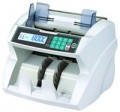Max. counting speed
The highest speed that device is able to count bills (coins in the relevant models, see "Product Type"). Higher speed saves time, but it also affects the price and sometimes the size of the device respectively. Its useful to note that using additional functions (for example, sorting by face), as well as in some other cases (such as dilapidated bills), the actual counting speed may slightly decrease compared to the claimed one.
As for specific figures, speeds
up to 1000 bills per minute are considered relatively low, but they are often quite enough in cases where large amounts are recalculated sporadically and high speed rate is not needed. In most counters (of all types), this indicator lies in the range
from 1000 to 2000 bills per minute, and
higher values found only in certain models of coin counters.
Load Tray capacity
The maximum amount of bills or coins that can fit in the pocket (tray) of the counter; in other words — the largest amount of monetary units that can be counted per one run without reloading (and when reloading money, it is worth considering the capacity of the receiving tray — see below)
Note that this parameter is quite approximate — bills can have different thickness, and furthermore, coins are usually arranged randomly. However, it is still undesirable to exceed the recommendations for capacity in order to avoid overloading the gears.
Receive pocket capacity
The largest amount of bills or coins that can fit in the counter's receiving pockets. For models with several receiving pockets (for sorting bills/coins), this paragraph usually indicates the total capacity of these pockets. In some devices, it is allowed to install an additional receiving pocket that expands the capacity; capacity of with such a pocket is indicated separately.
It should be taken into account that anyway this parameter is quite approximate, and the actual capacity may differ slightly from the claimed one: bills, even of the same currency, often have different thicknesses, and coins are scattered randomly in the pocket. Nevertheless, according to the claimed capacity, it is quite possible to evaluate different models of counting machines and compare them with each other.
It is worth noting that the receiving pocket often differs in capacity from the loading tray — sometimes up, sometimes down. This moment depends on the features of operating of the counter. So, if the receiving compartment is larger than the loading one, the device can be additionally loaded with a certain amount of money right during the counting, without any possibility of overflowing the receiver. And in the opposite case, when the counter is fully loaded, you will have to unload the receiver right in the process of operation — otherwise it will overflow before the loading tray is empty.
Authenticity Check
Types of authenticity check with certain signs on the money being counted and provided in the design of the counter. Only models for paper money are equipped with detection (see “Product Type”).
—
By size. A detection that involves determining the size of a bills. In bill counters, usually, it is used for sorting by face (see "Functions") or dilapidation, but it can also be used for other purposes — for example, identifying bills that are not related to the currency being counted.
—
By optical density. Detection based on optical density — the ability of a bills to transmit and retain light. It is mainly used to detect sticky bills and prevent counting errors, but can also be used to screen out worn or suspicious bills.
—
By magnetic marks. Detection based on the reading of magnetic marks. Typically, such marks are applied with a special paint, "noticeable" for magnetic sensors; note that they are widely used in US dollars and euros. This type of detection can be used both to determine the denomination and to separate bills in other currencies and detect counterfeit bills.
—
Ultraviolet (UV). Detection using UV radiation. Devices with this feature are able to detect special security elements that are visible only under ultraviolet light, and respond to the absence or non-standard arrangement of s
...uch elements. Due to this, it is possible to detect not only counterfeit or foreign bills, but also money marked with special compositions (for example, bills used as material evidence in a criminal case on a bribe and signed respectively). However, if the possibility of identifying marked bills is fundamentally important for you, its availability should be clarified additionally.
— Infrared (IR). Detection using infrared radiation. By the operating principle, it is similar to the UV detection described above, however, protective IR elements are less common, and their detection is technically more difficult. Therefore, this detection function is found mainly in hi-end devices, in particular, high-precision sorters (see "Product Type").Power consumption
The power consumed by the counter in regular operation mode. Usually, the regular mode means the counting process with all additional functions; in standby mode the power consumption is significantly less.
In most cases, this spec is relatively small — even high-end models rarely consume more than 400 watts. Therefore, this parameter has practical importance primarily in specific cases — for example, when calculating the load on a voltage stabilizer or an uninterruptible power supply.

